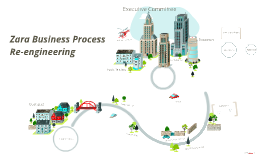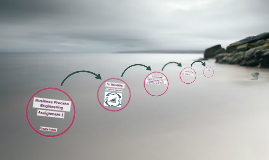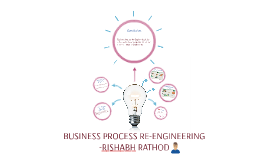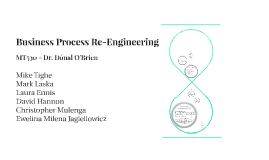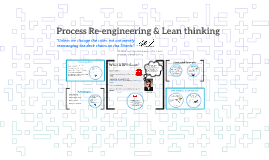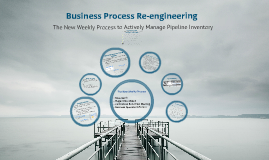Business Process Re-Engineering
Transcript: Bibliography: Albadvi, A., Keramati, A. & Razmi, J., 2007. Assessing the impact of information technology on performance considering the role of intervening organizational infrastructures and business process reengineering. International Journal of Production Research, 45(12), pp. 2697-2734. Al-Mashari, M., & Zairi, M., 1999. Business process re-engineering implementation process: an analysis of key success and failure factors. Business process management, 5 (1), 87-112. Boudreau, M.-C., & Robey, D., 1996. Coping with contradictions in business process re-engineering. Information Technology & People, 9 (4), 40-57. Browne, J., O’Sullivan, D., 1995. Re-engineering the Enterprise. London: Chapman and Hall. Burke, G., Peppard, J., 1995. Examining business process re-engineering. London: Kogan Carr, D.K., Johansson, H.J., 1995. Best Practices in Reengineering. New York: McGraw-Hill, Inc. Childe, S. J. & Bennett, M. J., 1994. Frameworks for Understanding Business Process Rengineering. International Journal of Production Management, 14(12), pp. 22-34. Coulson-Thomas, C., 1997. Business Process Re-engineering: myth & reality. London: Kogan Page Limited. Dutta, S., Manzoni, J.-F., 1999. Process re-engineering, organisational change and performance improvement. London: McGraw-Hill. Goel, S., Chen, V., 2008. Integrating the global enterprise using Six Sigma: Business Process Reengineering at General Electric Wind Energy. International Journal of Production Economics, Volume 113, pp. 914-927. Grover, V., Kettinger, W. (1995). Business process change. Harrisburg, USA: Idea Group Pub. Guimaraes, T., & Bond, W., 1996. Empirically assessing the impact of business process re-engineering on manufacturing firms. Gestao & Producao, 3 (1), 8-32. Habib, N. M., 2013. Understanding critical success and failure factors of business process re-engineering. International review of management and business research, 2 (1), 1-10. Holland, D., & Kumar, S. 1995. Getting past the obstacles to successful re-engineering. Business Horizon , 79-85. Johansson, H. J., McHugh, P., Pendlebury, A. J. & Wheeler III, W. A., 1993. Business Process Reengineering: BreakPoint Strategies for Market Dominance. 1 ed. Surrey: Britain: John Wiley & Sons Ltd. Lockamy, A., Smith, W. 1997. A strategic alignment approach for effective business process reengineering: linking strategy, processes and customers for competitive advantage. International Journal for production economics , 141-153. Obolensky, N., 1996. Practical Business Re-Engineering: Tools and Techniques for Achieving Effective Change. London: Kogan Page Limited. Paton, R.A., McCalman, J., 2000. Change Management: A guide to effective implementation. London: SAGE Publications Ltd. Peppard, J., Rowland, P., 1995. The essence of business process re-engineering. New York: Prentice-Hall. Petrozzo, D.P., Stepper, J.C., 1994. Successful Reengineering. New York: Van Nostrand Reinhold. Internet: Entrepreneurial-insights.com, (2014). [online] Available at: http://www.entrepreneurial-insights.com/business-competitive-business-process-reengineering-bpr/ [Accessed 8 Nov. 2014]. The Economist, 2009. Business process re-engineering. [online] Available at: http://www.economist.com/node/13130298 [Accessed 8 Nov. 2014]. Successful examples of BPR Four key steps to BPR: Mike Tighe Mark Laska Laura Ennis David Hannon Christopher Mulenga Ewelina Milena Jagiellowicz Causes of Failure: Problems in communication, leaders & support, ineffective BPR teams, poor project planning, lack of IT investment What is BPR? MT530 - Dr. Dónal O'Brien Why are companies using BPR? 1. Strategic processes 2. Operational processes 3. Enabling processes Thanks for your attention! We will gladly answer your questions now. Where is BPR appropriate? Business Process Re-Engineering 1. Corporate change 2. Overall performance: Streamline system Improve cost Example: Taco Bell K-Minus program 60-80% BPR Failure Rate Not every BPR implementation process has resulted in failure, e.g. Walmart, Ford Motors 5 critical success factors Al Mashari & Zairi (1991) Step 1: determine change Step 2: plan process of change Step 3: implementation of BPR Step 4: monitoring process Improvment Initiative - Examination of core business processes rather than o disparate business functions Benefits - Cost savings, improved productivity, competitive advantage Note of caution Reduce Staffing Needs Administrative tasks e.g. Order Management, Customer Service Previous levels of service with fewer staff Cost Reduction For key business processes e.g. Manufacturing, Design Use of new Information Technologies How to use BPR? When to use BPR?






